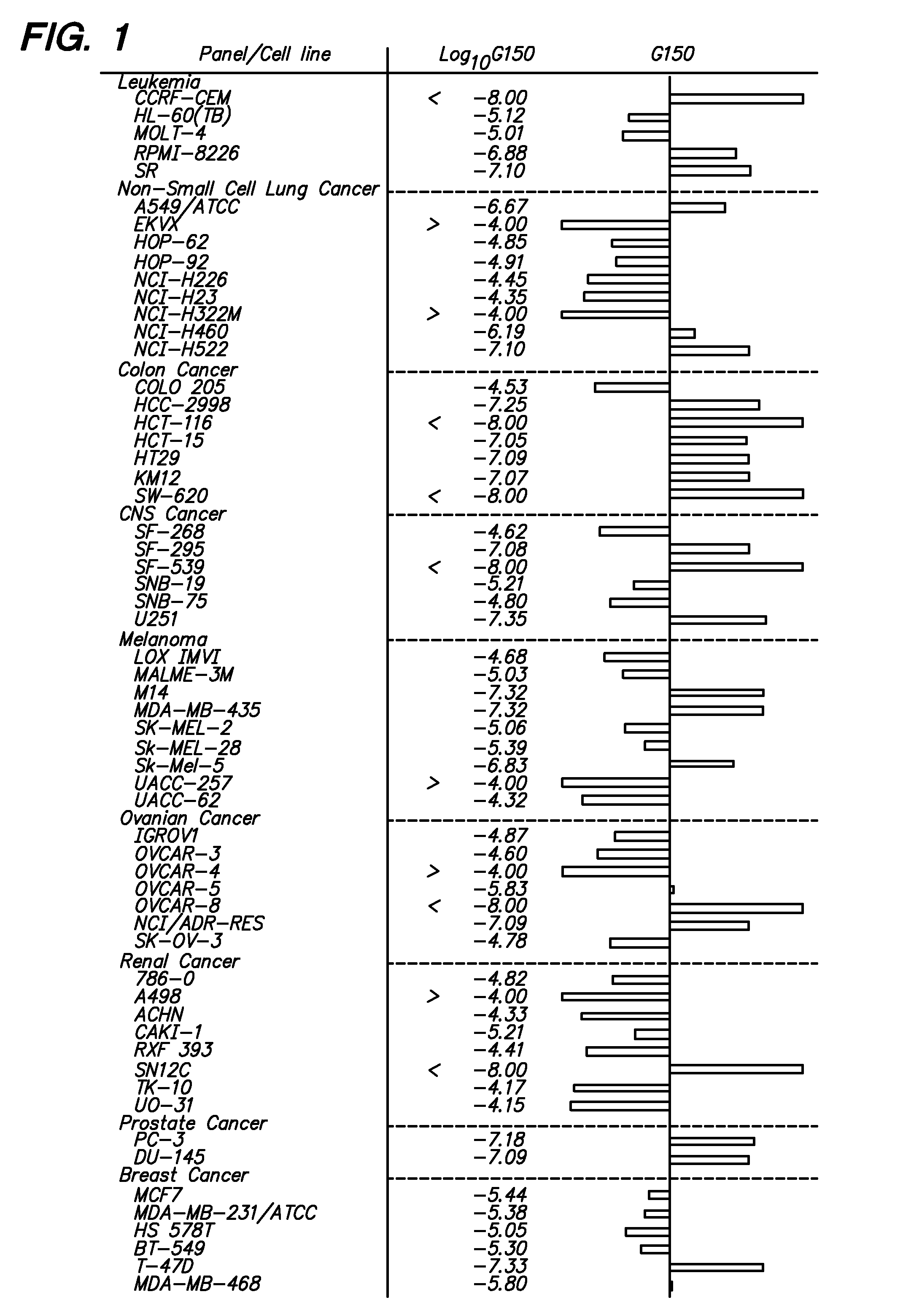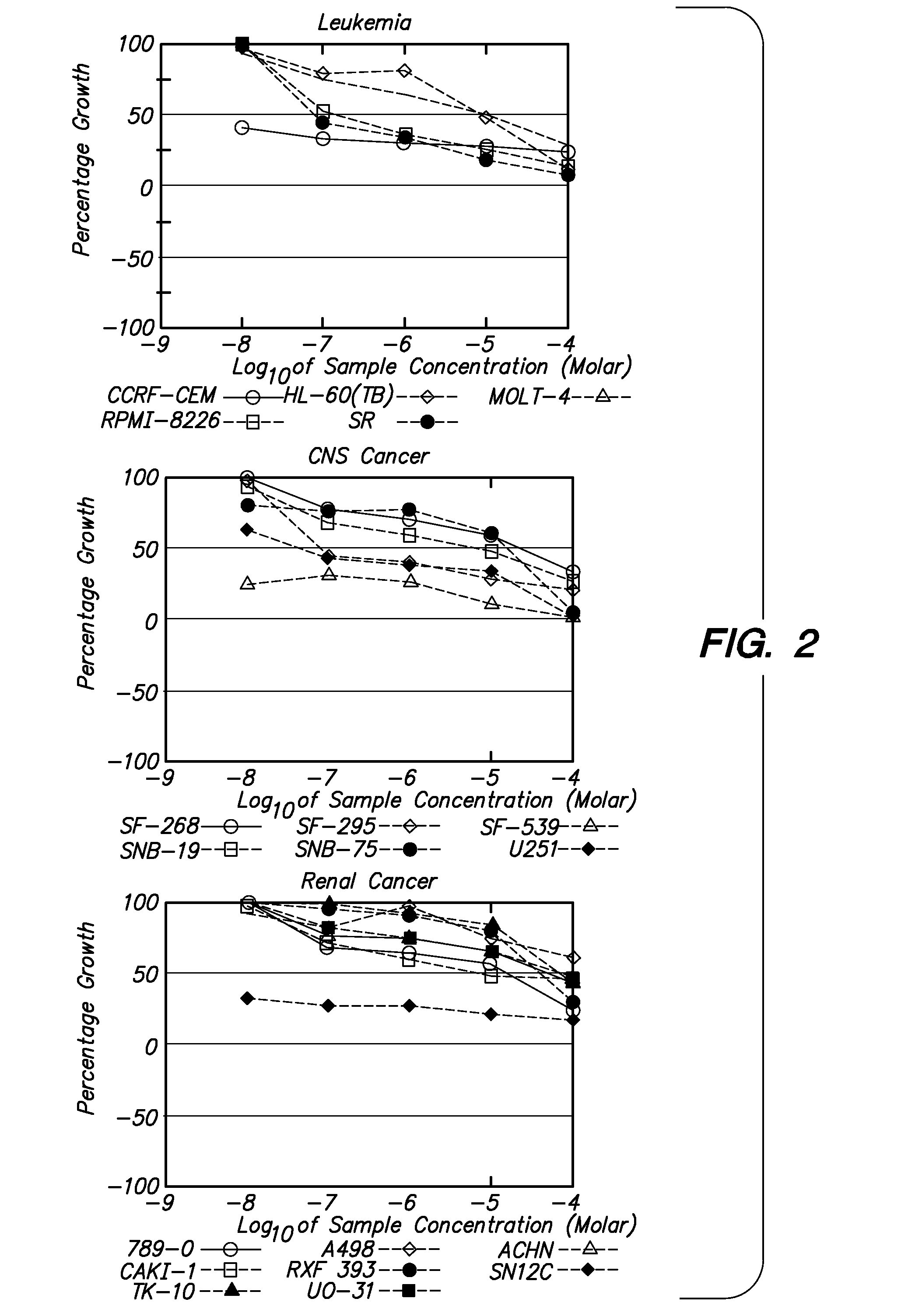Anti-proliferative compounds and methods for using the same
a technology applied in the field of anti-proliferative compounds and methods for using the same, can solve the problems of myeloid leukemia, significant therapeutic challenges, and particularly poor survival rate of very young and elderly people, and achieve the effect of inhibiting the proliferation of cancer cells
- Summary
- Abstract
- Description
- Claims
- Application Information
AI Technical Summary
Benefits of technology
Problems solved by technology
Method used
Image
Examples
example 1
Inhibitors of Human and Murine Cancer Cells and Cell Lines
[0235]The compounds have broad specificity and affect human cell lines of multiple lineages. The growth inhibitory properties were analyzed in human cancer cell lines derived from 9 different tissues in the NCI 60-cell line screen. To perform this assay, cells were plated in 96-well plates and incubated overnight. After 24 hours, compounds were added to the wells and plates. Two plates of each cell line were set aside and fixed in TCA to measure the quantity of cells present at the time drug was added (time 0). The remaining plates were incubated for 48 hours. The assay was terminated by addition of TCA, and the cells were quantified by staining the cellular proteins with sulforhadamine B. The growth inhibition (GI50) was calculated by dividing the difference between treated cells at the beginning and end of the assay by the difference between untreated cells at the beginning and end of the assay.
[0236]All compounds affected ...
example 2
Optimization of Structure Activity Relationships of Compounds
[0246]The chemical space surrounding lead compounds was explored through high-throughput screening of analogs to establish structure-activity relationships. The analogs, which are structurally similar to the active compounds, were acquired and prepared for a high-throughput screen. The compounds were selected to provide appropriate variability to identify the critical functional groups of the parent compound. The compounds were tested on ten human leukemia cell lines (5 with MLL rearrangements, 5 without).
[0247]Based on SAR results, active compounds are chemically modified by a chemical cross-linker onto dispensable side chains to allow for immobilization of the modified compounds on beads to allow identification of compound-small molecule interactions (Rix, U. & Superti-Furga, G. Target profiling of small molecules by chemical proteomics. Nat Chem Biol 5, 616-624, (2009)). Non-specific DNA binding has been ruled out as a ...
example 3
Efficacy of Compounds in Mouse Models of Leukemia
[0249]An amount of compound 1 was synthesized for use in pre-clinical efficacy studies. The formulation was selected to minimize side effects from the carrier. For example, formulations using a high concentration of captisol cause mild nephrotoxicity.
[0250]The in vivo efficacy of compound 1 was assessed in a xenograft model of human B-ALL. In this model, immuno-compromised (NSG) mice transplanted with the MV411 (MLL-AF4) human leukemia cell line invariably succumb to disease within 35-37 days. The MV411 cell line was genetically modified to constitutively express firefly luciferase, which permits bioluminescent imaging for non-invasive monitoring of tumor progression during efficacy studies.
[0251]Preliminary studies established that the MV411-lucifease cell line is highly sensitive to compound 1 with an IC50 of 10 nM and an IC100 of 25 nM (±20 nM). Pre-incubation of compound with FBS prior to cell treatment in vitro showed no effect o...
PUM
| Property | Measurement | Unit |
|---|---|---|
| temperature | aaaaa | aaaaa |
| concentration | aaaaa | aaaaa |
| concentrations | aaaaa | aaaaa |
Abstract
Description
Claims
Application Information
 Login to View More
Login to View More - R&D Engineer
- R&D Manager
- IP Professional
- Industry Leading Data Capabilities
- Powerful AI technology
- Patent DNA Extraction
Browse by: Latest US Patents, China's latest patents, Technical Efficacy Thesaurus, Application Domain, Technology Topic, Popular Technical Reports.
© 2024 PatSnap. All rights reserved.Legal|Privacy policy|Modern Slavery Act Transparency Statement|Sitemap|About US| Contact US: help@patsnap.com










